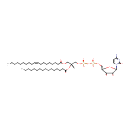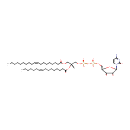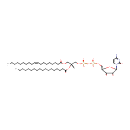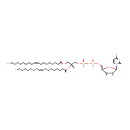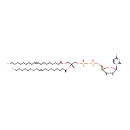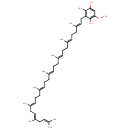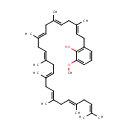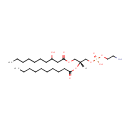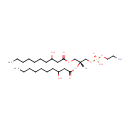
Search Results for compounds
Searching compounds for
returned 4373 results.
Displaying compounds 1981 - 1990 of
4373 in total
CDP-DG(19:1(9Z)/16:0) (PAMDB003777)
IUPAC:
{[(2R,3R,5R)-5-(4-amino-2-oxo-1,2-dihydropyrimidin-1-yl)-3,4-dihydroxyoxolan-2-yl]methoxy}({[(2R)-2-(hexadecanoyloxy)-3-[(9Z)-nonadec-9-enoyloxy]propoxy](hydroxy)phosphoryl}oxy)phosphinic acid
CAS: Not Available
Description: CDP-DG(19:1(9Z)/16:0) belongs to the family of CDP-diacylglycerols. It is a glycerophospholipid containing a diacylglycerol, with a cytidine diphosphate attached to the oxygen O1 or O2 of the glycerol part. As is the case with diacylglycerols, phosphatidylserines can have many different combinations of fatty acids of varying lengths and saturation attached to the C-1 and C-2 atoms. CDP-DG(19:1(9Z)/16:0), in particular, consists of one 9Z-nonadecenoyl chain to C-1 atom, and one hexadecanoyl to the C-2 atom. In Pseudomonas aeruginosa glycerophospholipid metabolism, The biosynthesis of CDP-diacylglycerol (CDP-DG) involves condensation of phosphatidic acid (PA) and cytidine triphosphate, with elimination of pyrophosphate, catalysed by the enzyme CDP-diacylglycerol synthase. The resulting CDP-diacylglycerol can be utilized immediately for the synthesis of phosphatidylglycerol (PG), and thence cardiolipin (CL), and of phosphatidylinositol (PI). CDP-DG(19:1(9Z)/16:0) is also a substrate of CDP-diacylglycerol pyrophosphatase. It is involved in CDP-diacylglycerol degradation pathway.
CDP-DG(19:1(9Z)/16:1(9Z)) (PAMDB003778)
IUPAC:
{[(2R,3R,5R)-5-(4-amino-2-oxo-1,2-dihydropyrimidin-1-yl)-3,4-dihydroxyoxolan-2-yl]methoxy}({[(2R)-2-[(9Z)-hexadec-9-enoyloxy]-3-[(9Z)-nonadec-9-enoyloxy]propoxy](hydroxy)phosphoryl}oxy)phosphinic acid
CAS: Not Available
Description: CDP-DG(19:1(9Z)/16:1(9Z)) belongs to the family of CDP-diacylglycerols. It is a glycerophospholipid containing a diacylglycerol, with a cytidine diphosphate attached to the oxygen O1 or O2 of the glycerol part. As is the case with diacylglycerols, phosphatidylserines can have many different combinations of fatty acids of varying lengths and saturation attached to the C-1 and C-2 atoms. CDP-DG(19:1(9Z)/16:1(9Z)), in particular, consists of one 9Z-nonadecenoyl chain to C-1 atom, and one 9Z-hexadecenoyl to the C-2 atom. In Pseudomonas aeruginosa glycerophospholipid metabolism, The biosynthesis of CDP-diacylglycerol (CDP-DG) involves condensation of phosphatidic acid (PA) and cytidine triphosphate, with elimination of pyrophosphate, catalysed by the enzyme CDP-diacylglycerol synthase. The resulting CDP-diacylglycerol can be utilized immediately for the synthesis of phosphatidylglycerol (PG), and thence cardiolipin (CL), and of phosphatidylinositol (PI). CDP-DG(19:1(9Z)/16:1(9Z)) is also a substrate of CDP-diacylglycerol pyrophosphatase. It is involved in CDP-diacylglycerol degradation pathway.
CDP-DG(19:1(9Z)/18:0) (PAMDB003779)
IUPAC:
{[(2R,3R,5R)-5-(4-amino-2-oxo-1,2-dihydropyrimidin-1-yl)-3,4-dihydroxyoxolan-2-yl]methoxy}({hydroxy[(2R)-3-[(9Z)-nonadec-9-enoyloxy]-2-(octadecanoyloxy)propoxy]phosphoryl}oxy)phosphinic acid
CAS: Not Available
Description: CDP-DG(19:1(9Z)/18:0) belongs to the family of CDP-diacylglycerols. It is a glycerophospholipid containing a diacylglycerol, with a cytidine diphosphate attached to the oxygen O1 or O2 of the glycerol part. As is the case with diacylglycerols, phosphatidylserines can have many different combinations of fatty acids of varying lengths and saturation attached to the C-1 and C-2 atoms. CDP-DG(19:1(9Z)/18:0), in particular, consists of one 9Z-nonadecenoyl chain to C-1 atom, and one octadecanoyl to the C-2 atom. In Pseudomonas aeruginosa glycerophospholipid metabolism, The biosynthesis of CDP-diacylglycerol (CDP-DG) involves condensation of phosphatidic acid (PA) and cytidine triphosphate, with elimination of pyrophosphate, catalysed by the enzyme CDP-diacylglycerol synthase. The resulting CDP-diacylglycerol can be utilized immediately for the synthesis of phosphatidylglycerol (PG), and thence cardiolipin (CL), and of phosphatidylinositol (PI). CDP-DG(19:1(9Z)/18:0) is also a substrate of CDP-diacylglycerol pyrophosphatase. It is involved in CDP-diacylglycerol degradation pathway.
CDP-DG(19:1(9Z)/18:1(9Z)) (PAMDB003780)
IUPAC:
{[(2R,3R,5R)-5-(4-amino-2-oxo-1,2-dihydropyrimidin-1-yl)-3,4-dihydroxyoxolan-2-yl]methoxy}({hydroxy[(2R)-3-[(9Z)-nonadec-9-enoyloxy]-2-[(9Z)-octadec-9-enoyloxy]propoxy]phosphoryl}oxy)phosphinic acid
CAS: Not Available
Description: CDP-DG(19:1(9Z)/18:1(9Z)) belongs to the family of CDP-diacylglycerols. It is a glycerophospholipid containing a diacylglycerol, with a cytidine diphosphate attached to the oxygen O1 or O2 of the glycerol part. As is the case with diacylglycerols, phosphatidylserines can have many different combinations of fatty acids of varying lengths and saturation attached to the C-1 and C-2 atoms. CDP-DG(19:1(9Z)/18:1(9Z)), in particular, consists of one 9Z-nonadecenoyl chain to C-1 atom, and one 9Z-octadecenoyl to the C-2 atom. In Pseudomonas aeruginosa glycerophospholipid metabolism, The biosynthesis of CDP-diacylglycerol (CDP-DG) involves condensation of phosphatidic acid (PA) and cytidine triphosphate, with elimination of pyrophosphate, catalysed by the enzyme CDP-diacylglycerol synthase. The resulting CDP-diacylglycerol can be utilized immediately for the synthesis of phosphatidylglycerol (PG), and thence cardiolipin (CL), and of phosphatidylinositol (PI). CDP-DG(19:1(9Z)/18:1(9Z)) is also a substrate of CDP-diacylglycerol pyrophosphatase. It is involved in CDP-diacylglycerol degradation pathway.
CDP-DG(19:1(9Z)/19:1(9Z)) (PAMDB003781)
IUPAC:
{[(2R,3R,5R)-5-(4-amino-2-oxo-1,2-dihydropyrimidin-1-yl)-3,4-dihydroxyoxolan-2-yl]methoxy}({[(2R)-2,3-bis[(9Z)-nonadec-9-enoyloxy]propoxy](hydroxy)phosphoryl}oxy)phosphinic acid
CAS: Not Available
Description: CDP-DG(19:1(9Z)/19:1(9Z)) belongs to the family of CDP-diacylglycerols. It is a glycerophospholipid containing a diacylglycerol, with a cytidine diphosphate attached to the oxygen O1 or O2 of the glycerol part. As is the case with diacylglycerols, phosphatidylserines can have many different combinations of fatty acids of varying lengths and saturation attached to the C-1 and C-2 positions. CDP-DG(19:1(9Z)/19:1(9Z)), in particular, consists of two 9Z-nonadecenoyl chain at positions C-1 and C2. In Pseudomonas aeruginosa glycerophospholipid metabolism, The biosynthesis of CDP-diacylglycerol (CDP-DG) involves condensation of phosphatidic acid (PA) and cytidine triphosphate, with elimination of pyrophosphate, catalysed by the enzyme CDP-diacylglycerol synthase. The resulting CDP-diacylglycerol can be utilized immediately for the synthesis of phosphatidylglycerol (PG), and thence cardiolipin (CL), and of phosphatidylinositol (PI). CDP-DG(19:1(9Z)/19:1(9Z)) is also a substrate of CDP-diacylglycerol pyrophosphatase. It is involved in CDP-diacylglycerol degradation pathway.
6-Methoxy-3-methyl-2-all-trans-octaprenyl-1,4-benzoquinol (PAMDB003826)
IUPAC:
5-methoxy-2-methyl-3-[(2E,6E,10E,14E,18E,22E,25E)-3,7,11,15,19,23,26,29-octamethyltriaconta-2,6,10,14,18,22,25,28-octaen-1-yl]benzene-1,4-diol
CAS: Not Available
Description: 6-Methoxy-3-methyl-2-all-trans-octaprenyl-1,4-benzoquinol is involved in the ubiquinol-8 biosynthesis pathway. It is a substrate of 2-octaprenyl-3-methyl-6-methoxy-1,4-benzoquinone hydroxylase that catalyses the following reaction:6-methoxy-3-methyl-2-all-trans-octaprenyl-1,4-benzoquinol + a reduced electron acceptor + oxygen => 3-demethylubiquinol-8 + an oxidized electron acceptor + H2O
2-methoxy-6-(all-trans-octaprenyl)phenol (PAMDB003827)
IUPAC:
2-methoxy-6-[(2E,5E,8E,11E,14E,17E,20E)-3,6,9,12,15,18,21,24-octamethylpentacosa-2,5,8,11,14,17,20,23-octaen-1-yl]phenol
CAS: Not Available
Description: 2-methoxy-6-(all-trans-octaprenyl)phenol is involved in the ubiquinol-8 biosynthesis pathway. It is a substrate for the 2-octaprenyl-6-methoxyphenol hydroxylase that catalyses the following reaction: 2-methoxy-6-(all-trans-octaprenyl)phenol + NADPH + oxygen + H+ => 2-methoxy-6-all trans-octaprenyl-2-methoxy-1,4-benzoquinol + NADP+ + H2O
PE(10:0(3-OH)/10:0) (PAMDB003829)
IUPAC:
(2-aminoethoxy)[(2R)-2-(decanoyloxy)-3-[(3-hydroxydecanoyl)oxy]propoxy]phosphinic acid
CAS: Not Available
Description: PE(10:0(3-OH)/10:0) is a phosphatidylethanolamine. It is a glycerophospholipid in which a phosphorylethanolamine moiety occupies a glycerol substitution site. As is the case with diacylglycerols, glycerophosphoethanolamines can have many different combinations of fatty acids of varying lengths and saturation attached to the C-1 and C-2 atoms. PE(10:0(3-OH)/10:0), in particular, consists of one 3-hydroxydecanoyl chain to the C-1 atom, and one decanoyl to the C-2 atom. While most phospholipids have a saturated fatty acid on C-1 and an unsaturated fatty acid on C-2 of the glycerol backbone, the fatty acid distribution at the C-1 and C-2 positions of glycerol within phospholipids is continually in flux, owing to phospholipid degradation and the continuous phospholipid remodeling that occurs while these molecules are in membranes. PEs are neutral zwitterions at physiological pH. They mostly have palmitic or stearic acid on carbon 1 and a long chain unsaturated fatty acid (e.g. 18:2, 20:4 and 22:6) on carbon 2. PE synthesis can occur via two pathways. The first requires that ethanolamine be activated by phosphorylation and then coupled to CDP. The ethanolamine is then transferred from CDP-ethanolamine to phosphatidic acid to yield PE. The second involves the decarboxylation of PS.
PE(10:0(3-OH)/10:0(3-OH)) (PAMDB003830)
IUPAC:
(2-aminoethoxy)[(2R)-2,3-bis[(3-hydroxydecanoyl)oxy]propoxy]phosphinic acid
CAS: Not Available
Description: PE(10:0(3-OH)/10:0(3-OH)) is a phosphatidylethanolamine. It is a glycerophospholipid in which a phosphorylethanolamine moiety occupies a glycerol substitution site. As is the case with diacylglycerols, glycerophosphoethanolamines can have many different combinations of fatty acids of varying lengths and saturation attached to the C-1 and C-2 positions. PE(10:0(3-OH)/10:0(3-OH)), in particular, consists of two 3-hydroxydecanoyl chains at positions C-1 and C-2. While most phospholipids have a saturated fatty acid on C-1 and an unsaturated fatty acid on C-2 of the glycerol backbone, the fatty acid distribution at the C-1 and C-2 positions of glycerol within phospholipids is continually in flux, owing to phospholipid degradation and the continuous phospholipid remodeling that occurs while these molecules are in membranes. PEs are neutral zwitterions at physiological pH. They mostly have palmitic or stearic acid on carbon 1 and a long chain unsaturated fatty acid (e.g. 18:2, 20:4 and 22:6) on carbon 2. PE synthesis can occur via two pathways. The first requires that ethanolamine be activated by phosphorylation and then coupled to CDP. The ethanolamine is then transferred from CDP-ethanolamine to phosphatidic acid to yield PE. The second involves the decarboxylation of PS.
PE(10:0(3-OH)/12:0) (PAMDB003831)
IUPAC:
(2-aminoethoxy)[(2R)-2-(dodecanoyloxy)-3-[(3-hydroxydecanoyl)oxy]propoxy]phosphinic acid
CAS: Not Available
Description: PE(10:0(3-OH)/12:0) is a phosphatidylethanolamine. It is a glycerophospholipid in which a phosphorylethanolamine moiety occupies a glycerol substitution site. As is the case with diacylglycerols, glycerophosphoethanolamines can have many different combinations of fatty acids of varying lengths and saturation attached to the C-1 and C-2 atoms. PE(10:0(3-OH)/12:0), in particular, consists of one 3-hydroxydecanoyl chain to the C-1 atom, and one dodecanoyl to the C-2 atom. While most phospholipids have a saturated fatty acid on C-1 and an unsaturated fatty acid on C-2 of the glycerol backbone, the fatty acid distribution at the C-1 and C-2 positions of glycerol within phospholipids is continually in flux, owing to phospholipid degradation and the continuous phospholipid remodeling that occurs while these molecules are in membranes. PEs are neutral zwitterions at physiological pH. They mostly have palmitic or stearic acid on carbon 1 and a long chain unsaturated fatty acid (e.g. 18:2, 20:4 and 22:6) on carbon 2. PE synthesis can occur via two pathways. The first requires that ethanolamine be activated by phosphorylation and then coupled to CDP. The ethanolamine is then transferred from CDP-ethanolamine to phosphatidic acid to yield PE. The second involves the decarboxylation of PS.
